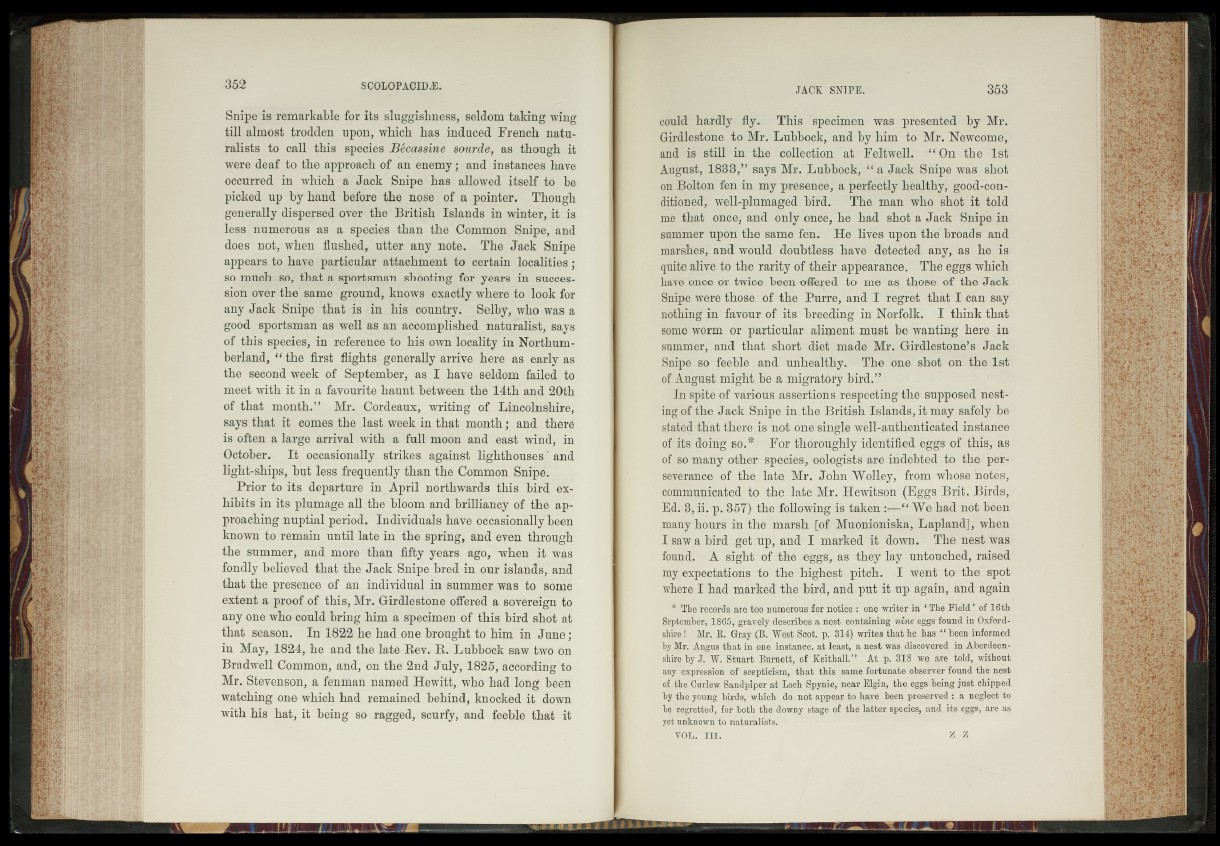
Snip© is remarkable for its sluggishness, seldom taking wing
till almost trodden upon, which has induced French naturalists
to call this species Bécassine sourde, as though it
were deaf to the approach of an enemy ; and instances have
occurred in which » Jack Snipe * has allowed itself to be
picked up by hand before the nose of a pointer. Though
generally dispersed over the British Islands in winter, it is
less numerous as a species than the Common Bnipe, and
does not, when flushed,. utter any note. The Jack Snipe
appears to have particular attachment to certain localities ;
so .minch so, that a. sportsman shooting for years in- succession
over the same ground, knows exactly where to look for
any Jack Snipe that is in. his country. _Selby, who was a
good sportsman-as well as an accomplished "Naturalist, says
of this species, in reference to his own locality in Northumberland,
“ the first flights generally arrive here as early as
the second week of September, as I have seldom failed to
meet with it: in a favourite haunt between the 14th and 20th
of that month.” Mr. Cordeaux, writing of Lincolnshire,
says that it comes the last, week in that month ; and iheré
is often a large arrival with a full mpôn and past wind, in
October. .It occasionally strikes against lighthouses‘ and
light-ships, but less frequently than the Common Snipe. I
Prior to its departure in April northwards this bird ex-;
hibits in its plumage all the bloom and brilliancy o^ the approaching
nuptial period. Individuals have occasionally then
known to remain until late in» the spring; and even through
the summer, and more than fifty years ago, when it "was
fondly believed that the Jack Snipe bred in our islands, and
that the presence of an individual in summer Was to“sojmé
extent a proof of this, Mr. Girdlestone offered a sovereign to
any one who could bring him a Specimen of this bird shot at
that season r In 1822'he Had one brought'to him in June*;
in May, 1824, he and thel&toBev* R. Lubbock saw two on
Bradwell CommOP, and, on the 2nd July, 1825,- according to
Mr. Stevenson, a fénman named Hewitt, who had long' bëèîf
watching one which had remained behind, knocked it down
with his hat, it being so ragged, scurfy, and feeblo that it
cduld hardly fly.f This “specimen was presented by Mr.
Otirdlestone Jto .Mr. Lubbock, .andrby him "to. Mr. Newcome^
and is still in the collection. 'af Feltwell. “ Oh the 1st
August, 1838,” says Mr. Lubbock, a Jack Snipe was shot
on Bolton fen in my presence, a perfectly^healthy, good-conditioned,^
well-plumaged bird." The man who shot it told
me that ppce, and only once, he had shot a Jack Snipe in
summer upon the same fen: He lives upon the* broads and
marshes,'and would doubtless have detected any, as he’ is
quite alive to .the rarity:of their appearance. ■ The eggs which1
have hnce or:twice..béefi-^Eared to me as those of the Jack:
Snipe were those of the Purre,';and T regret that I can say
nothing in favour ofMts breeding in Norfolk. I think that’
some’:worm- or.:particular, aliment must h©-wanting here in
summer,-and that ■ short-diet made Mr. Girdlestone’s Jack
Snipe:scÉ%feè’bfè%and' unhealthy;^ The one’ shot"on^the 1st'
of August .might he a'.migratory‘bird.” *
-Irispite of various assertions respecting the supposed nest-':
ing ofidhe .J%ckv Snipe in. the British Islands, it may safely:be
stated'that there.is hot one?single" WelPauthenticated instance^
of its'dóihg so.*-. 'For thoroughly identified;ëggsjof this, as
of |govmany other species; eulogists are'indebted t© *fhel perseverance;’
Of thé: late life.ciJbh'n Wolley,“ from’whose notes,
communicated to. the late Mr. Hewitson (Eggs:Briri Birds,
Ed; 3, ii.p.i§f>7)i the following isiakem:—“ Wa'had not been'
manyfhohrs jnfheimarsh' [of :Muoniohi®ka, • LaplandJfLwhen
I sawa bird get.up, and I marked'it down/5 'fhe’hestwas
found. A sight "of [the -eggs, as they lay:,untouched, raised
mytéxpecfations :to¥ithe 'highesfelpitch. I went 'to . the7 spot
whera.1 had.marked:the bird, and put it up. again;-and-again
*- Thp records areioblnumerous for 'i>nV writer in 1 The Field:’ óf 16th
September,^865','gravely describes,a nest’containing'wiiilè£gg& fonndin Oxford-
sldpfc)i* Nr. R. (R.. West Scat, p; 3jA) writes that bp has “ bpep informed
by Mr. -Angus t f ^ m instance, a t least, a nest was discovered. in ^bprdeen-
sÉirg byD? WrStuart'^^hiétt, o$ Kèrtd^L’ ?• we
any. expression of’'scepticism,' that this same fortunate obseryir’foimd -the nest
of the Onrre^-^andpi-per-athoch Spynie, near Elgin, the’eggs heing jusitj Chipped
by theijMxiingi Airda. .Tghip.h do not app^tjf, to hajfe been preserved : a neglect to
he Sfgretted', fo?-Both' the 'downy stage" ojE ’the latter species,.„abAitj^gs', axe as
yet'unknown t$-natiHffiKit'sjj
Z ; YQL. X ll.H & j2